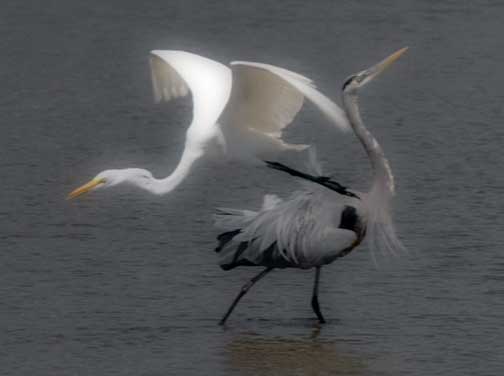This page features one photograph from my portfolio taken each month so far this year
with which I am particularly pleased and for which there is an interesting story.
November, 2003
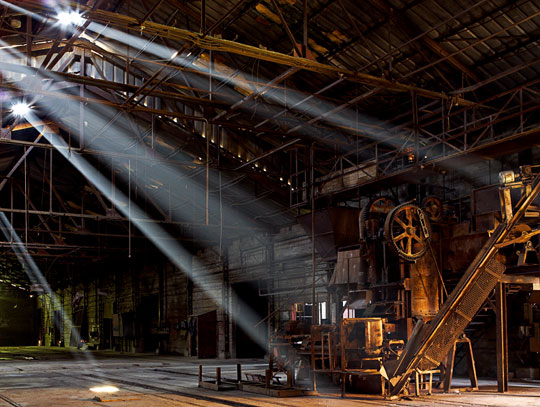
Brickworks #7 — Toronto. November, 2003
Contax 645 with 35mm f/4 Distagon
& Kodak DCS Pro-Back @ ISO 100
This abandoned brickworks is close to downtown Toronto. I had visited the site many times but had always found the building fenced off and sealed. On a Fall morning I came across an open doorway and spent a magical hour exploring the dark recesses of this bizarre location. This was followed by a second morning’s visit, and resulted in an article on this site titledArchitecture as Landscape. This series of photographs will be featured in a gallery exhibit in Toronto in early 2004.
And, to answer the obvious question — the light beams are completely real. They are caused by holes in a slanted tin roof and enhanced by the very dusty air inside the brickworks.
October, 2003
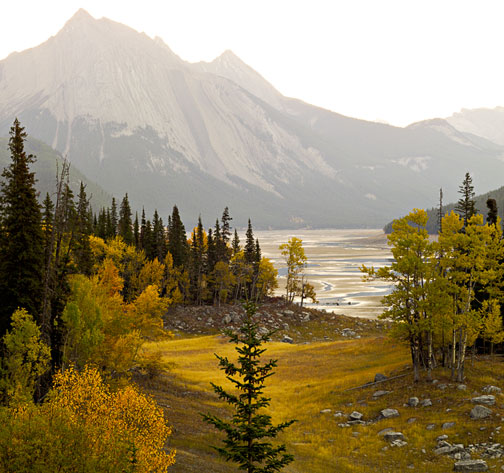
Golden Path — Jasper National Park, Canada
Contax 645 with 120mm f/4 Apo-Makro Planar
and Kodak DCS Pro Back @ ISO 100
Sometimes the best frames from a shoot are not the ones that one thinks at the time will be the "keepers". In this case we were shooting along theMaligne Lake RoadinJasper National Parkduring a week-longFall Colour shootin the Canadian and Northern U.S. Rocky Mountains. This particular frame was made in an almost off-hand manner. Yes, of course it appealed at the time. Otherwise I wouldn’t have taken it. But after framing and making the exposure I hardly gave it another thought. It wasn’t until the following week as I was reviewing RAW files on-screen that it jumped out at me.
The warmth of the light and foliage plays a large role, but there’s more to it than that. The square composition "works", and the soft manner in which the distant mountain is rendered is gentle and appealing. Few of my photographs this year have elicited more comment, or more print orders.
September, 2003

Deserted Distillery — September, 2003
Contax 645 with 35mm f/3.5 Distagon
and Kodak DCS Pro Back 645 @ ISO100
In mid-September the well known photographer and authorCteinvisited Toronto and we had an opportunity to meet, chat and do a bit of shooting together. On one of these days we had lunch in the historicDistillerydistrict, which is in the process of being gentrified. Wondering about after lunch we came across a room that will likely one day house a ladies boutique or art gallery, but on this day was in the midst of clean-up and restoration. The crew were at lunch, and upon seeing the potential I ran back to where I was parked and grabbed my camera and tripod from the trunk.
The challenge here was that the brightness range covered at least 9 stops. I managed to hold at least 7-8 by digitally blending two frames taken 2 stops apart, though I did allow the outside to burn out, which still looks quite natural. Only a digital blend would have made this work, since a split ND filter couldn’t have done the job because of the irregular window shapes.
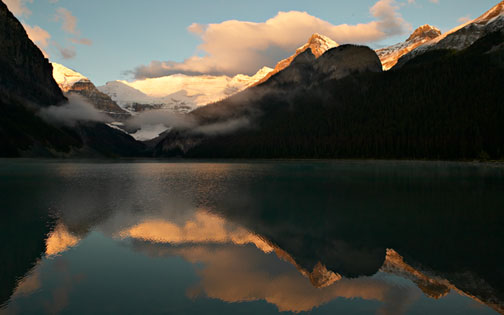
Lake Louise Sunrise — Alberta, Canada — September, 2003
Canon 1Ds with 24-70mm f/2.8L @ ISO 100
Later in the month I vacationed in atLake LouiseinBanff National Park. Banff is the iconic National Park of Canada, and I hadn’t visited there in a great many years. We had poor weather for vacationing, with snow and rain, but the light on some days was quite glorious. The above image is part of a smallportfoliofrom that trip.
August, 2003
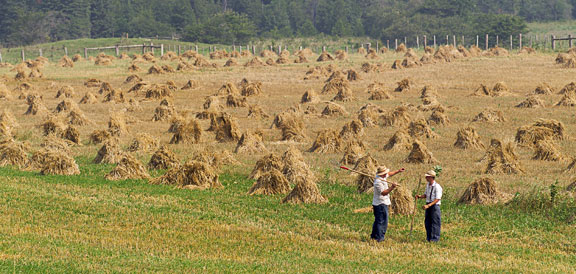
Farm Talk, Ontario — August, 2003
Contax 645 with Kodak DCS Pro Back with 210mm f/4 Sonnar @ ISO 100
Two photographs share the honours this month. They were taken a day apart on a shoot in Ontario farm country along the eastern shore of Lake Huron. Both were taken with the same lens, and each was shot late-morning on a sunny day — not usually the ideal time for landscape photography. In each case though I feel that the "mood" of the late August harvest time in a rural setting has been captured.
In the case of the hay field and farm hands, my wife’s initial comment upon seeing it was , "Imitating Van Gogh now, are we?" Hmm. I suppose, though frankly I think it’s simply a case of life imitating art.
The image below appeals to me because of its graphic simplicity. The sky is allowed to dominate proportionally, even though it doesn’t contain the major subject interest, because of how it contrasts with the darker tones and heavier textures of the corn rows and stubble field. The barn roof, just slightly off center, anchors the frame by bringing the sky and foreground together.

Corn Field, Ontario — August, 2003
Contax 645 with Kodak DCS Pro Back with 210mm f/4 Sonnar @ ISO 100
July, 2003
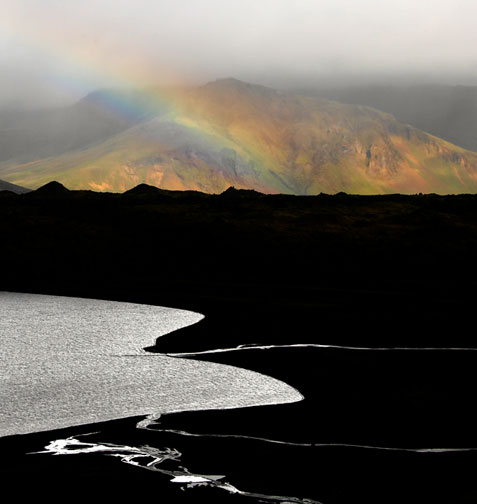
Rainbow Lake. Iceland — July, 2003
Canon 1Ds with 70-200mm f/2.8L IS @ ISO 100
As a landscape photographer I take carewhereI go to shoot, andwhen, in the hope of being in control of the time and place for making meaningful images. And, like most photographers heading to an exotic location, such asIceland, I have preconceptions of the type of images that I hope to make. Rarely does reality match these preconceptions though.
This was contradicted when taking the above photograph on the next to last day of our week-long shoot in Iceland in the summer of 2003. I was feeling a bit dejected, as several days had gone by and nothing extraordinary had presented itself. But then in the mid-morning we found ourselves skirting a row of rain clouds, with shafts of sunlight occasionally lancing though and hints of rainbows visible as we drove a twisting mountain road. But no subject presented itself.
Then, I hit the brakes as this scene appeared. I instantly saw that it had all of the elements that I look for in aluminous landscape. It had taken 6 days and some 3,000 km of driving to come across this moment. The rainbow lasted just seconds, and then vanished, but not until after I had taken a few frames.
Later that day at a lunch stop I eagerly transferred the CF card to my laptop computer, and when I saw the RAW file I knew that it had it nailed. Other than some cropping the only changes made to the original were to increase contrast a bit so as to make the dark volcanic foreground almost completely black and the lake a bit brighter. Not quite "f/8 and be there", but close.
June, 2003
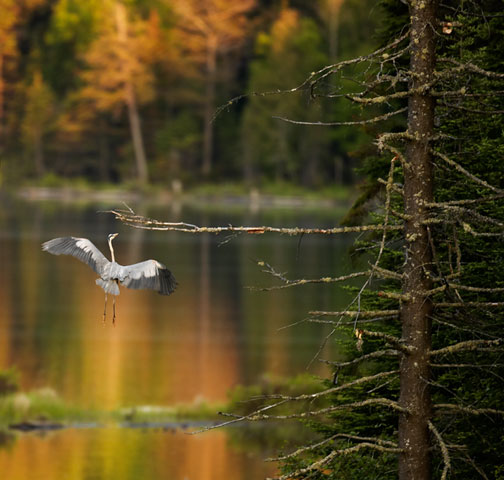
Vertical Landing — Algonquin Provincial Park, Ontario. June, 2003
Photographed with a Canon 1Ds and 500mm f/4L IS lens. ISO 200
What is it with heron? They really don’t like having their photograph taken. Look at a heron sideways, let alone try and get near one, and they take flight. Yet, they are such a ubiquitous bird, in North America at least, and so large and beautiful, that they are a constant challenge to wildlife photographers.
This one was not on my "to do" list, but during a three day wildlife shoot inAlgonquin Provincial Parkin north-central Ontario in early June this turned out to be one of the best images taken during the trip. A short essay titledLuckexplains more about the making of this image and discusses some issues related topreparednesswhen doing wildlife shooting.

Dune Landscape — Death Valley. May, 2003
Canon 1Ds with 70-200mm f/2.8L lens @ 130mm. ISO 100
Mid-month I lead a 5 day workshop inDeath Valleythat would include photographing alunar eclipse. On our first afternoon we explored the sand dunes nearStovepipe Wells. I’d shot there several times before, but on this evening the twilight was particularly soft and warm. I took quite a few successfuldune abstracts, but as the light faded I made one last frame of the broader landscape.
While theeclipse photographis dramatic and unique, it has some compositional deficiencies. On the other hand the photograph above appears to me to have an almost perfect balance of tonalities, palette and composition. Unfortunately much of the subtlety doesn’t come through except in a large print.
Postscript:When this frame first appeared on my screen in Photoshop I knew that it reminded me of a photograph that I’d seen before, but I couldn’t place it. About a week later I found it —Plate 71inWilliam Neil’sLandscape of The Spirit. Neil is a photographer whose work I regard very highly. Though his image was taken nearly 25 years ago, and at dawn rather than sunset, the "feeling" and the nature of the light is very similar. If you own a copy of this wonderful book you may enjoy the comparison.
April, 2003

Dawn Reflection — Loxahatchee National Wildlife Reserve, Florida. April, 2003
Fuji S2 Pro with Nikon 35-70mm f/2.8 D lens at ISO 160
I had a lot of equipment tests scheduled for April, but somehow couldn’t properly coordinate my travel schedule with when various pieces of gear became available. Since my camera tests are actual photographic field tests, not simply a matter of enumerating knobs and features, this proved frustrating. But during the 10 days that I had aFuji S2 Proavailable for testing I manage to make a brief family orientated visit to Florida, and had several mornings to shoot at one of my favourite locations for birds,Loxahatchee National Wildlife RefugenearBoca Raton.
While I usually shoot with a 300-500mm lens in a location like this, the only lens that I had with me for the Fuji that morning was a Nikon 35-70mm zoom. At first I despaired at being able to produce anything worthwhile, but then just at dawn saw this tranquil scene unfold. It very much fits in with my preference for "environmental wildlife" photography, where rather than tight portraits of birds and animals I try and show them in the context of their natural environment. Landscapes with wildlife, if you will.
March, 2003
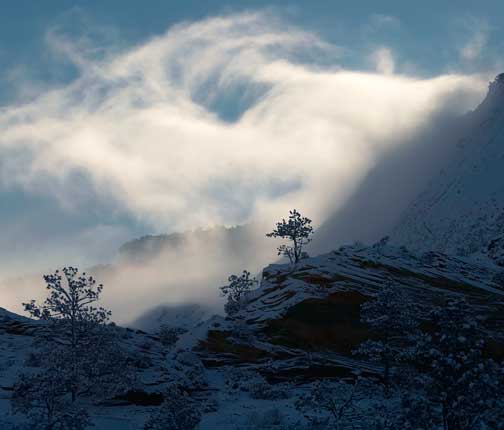
Cloud Swirl — Zion N.P., March 2003
Canon 1Ds with 70-200mm f/2.8L lens @ 200mm. ISO 100
An early Marchweek-long shootin several National Parks in southern Utah was very productive. One early morning in Zion National Park produced a unique early morning shoot with fresh snow on red rock and swirling clouds on the hillsides.
In addition tolightandlocationthe next most important component for a successful landscape photograph are "atmospherics". Clouds can be a critical element in making or breaking an image, and in the photograph above they have become a vital component.
These clouds were moving so quickly (though there was no wind at all where we were standing) that the scene before us was constantly changing. Features would be obscured one second, and bright blue sky would predominate the next. There was no point in waiting so we just shot what appealed. This frame is the one that best captures for me the combination of light and clouds along with a strong foreground interest.
February, 2003
Canon EOS 1Ds with 100-400mm f/5.6L IS lens @ 560mm with 1.4X. ISO 400
No, it’s not a superimposition or digital fake. This Egret flew by the posturing Heron and I was able to capture it at the perfect moment. Luck as well as skill, I assure you. I was photographing the Heron, two of them in fact, and out of the corner of my eye saw the Egret approaching. I quickly set the Image Stabilization to Mode 2 and autofocus to AI Servo. Shutter speed was 1/500sec and aperture was set to f11.
I started panning with the Egret and fired a single frame at what I hoped would be the right moment. Even though everything worked very well I was quite far away and this crop shows only about 20% of the full frame. I would have needed to be shooting at about 1000mm for them to fill the frame. I did a bit of "processing" to get the texture and "feel" that worked best with the image, but otherwise this is a straight photograph.
January, 2003
Canon EOS 1Ds with 300mm f/2.8L @ ISO 400
I did a 3 day winter landscape shoot in and nearMt. Tremblant National Parkin Quebéc in mid-January. On this particular trip we had not specifically planned to be on location at the time of month of a full moon. Fortuitously it just worked out that way. The moon can almost always make a strong contribution to landscape photographs.
On the second day, as the sun began to set, we started to look for a vantage point that might include a rising moon just before sunset. This was tough because the roads were twisty, the height of the mountains varied, and the ability to pull over to shoot limited by high snow banks.
Just before the sun dropped below the horizon we drove up a small mountain road and saw an opening in the trees. We jumped out of the car and just had a minute or two to take a few hand-held frames before the last rays of warm light left the foreground hills.
Another landscape photograph that incorporates the moon, that was taken about 35 minutes later than the one above can be seenhere.
featured images from 2002 are foundhere.
featured images from 2001 are foundhere.
featured images from 2000 are foundhere.
You May Also Enjoy...
Canon EOS-1V
A Hands-On — First-Impression Review Canon EOS-1v In early April, 2000 the CanonEOS-1Vstarted to become available in Canada — right on schedule, and somewhat ahead
Better Beamer
Success‚ In a Flash Most photographers understand the benefits of using fill flash under harsh lighting conditions. Most modern cameras using either built-in flash heads
